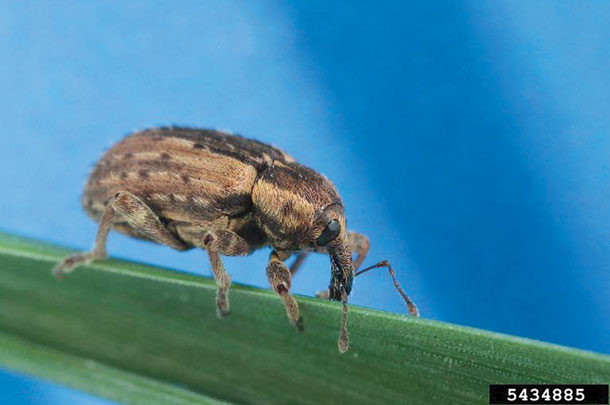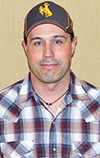However, this arid climate does not protect our haycrops from other pests, and one in particular is the alfalfa weevil (Hypera postica). The alfalfa weevil is the most destructive insect pest to alfalfa hay in the intermountain plains of the West. According to Colorado State University, alfalfa weevil has been a problem in their alfalfa production since the early 1900s.
Alfalfa weevil 101
So what is an alfalfa weevil? Adult alfalfa weevils are snout beetles, approximately a quarter-inch in length, that are brownish-grey with a dark brown band down the back. Adult alfalfa weevils overwinter in the crowns of alfalfa plants and become active in the spring once average temperatures warm above 48ºF.
During the spring, female weevils are busy laying eggs by chewing holes in new and dead alfalfa stems, then depositing the lemon yellow-colored eggs in clusters of five to 40 eggs inside these cavities. Each female will lay between 400 and 1,000 eggs a season.
Prior to hatching, the eggs will turn from the lemon yellow color to a dark brown. The young larvae emerge from the stem seven to 14 days after the eggs are laid. The weevil larva is a grub yellowish-green in color with a shiny black head and curved body that is 1/20 of an inch.

The newly emerged larvae feed on terminal alfalfa leaves prior to unfurling, while mature larvae feed on unfurled mature leaves. Alfalfa weevil larvae develop through four instar stages. By the third instar stage, a white stripe is visible down the center of the curved body.
It takes approximately three to four weeks for the larvae to develop from first instar to fourth instar, at which point the mature larvae then move to the crown of the alfalfa plant to pupate into loosely woven cocoons.
After seven to 14 days in the cocoon, depending on temperatures, the weevil emerges as an adult or snout beetle. The adult beetles reduce their feeding on alfalfa plants for the rest of summer and focus on mating and surviving the winter. The complete life cycle is typically one generation per year in the Western intermountain plains.
Monitoring
For the record, alfalfa weevil populations do not always reach economic thresholds that warrant control. Therefore, monitoring your fields is advantageous. It has been found that a density of one larva per 30 plants 12 inches tall can reduce yields by about 3 pounds per acre. However, alfalfa weevil impact on yield decreases with plant height, so the same density on 16-inch-tall plants was approximately 0.75 pounds per acre.
Typically, alfalfa weevil larvae do the most damage to the first cutting through defoliation of the leaves and are typically out of the fields for second cutting. However, if the damage to first cutting is significant enough, then there could be major influences on the vigor of second cutting, resulting in further yield loss.
Since alfalfa weevil larvae grow and develop incrementally at almost a constant rate, which is directly related to the increasing spring temperatures above 48ºF, a growing degree-day calculator can be utilized to determine the approximate date to monitor for growth stages and infestation (population).
A growing degree-day calculator estimates the amount of accumulative days that have reached or exceeded 48ºF utilizing a high-low temperature gauge through the following daily calculation (see equation on opposite page).
The degree days are then totaled to represent cumulative degree days (DD) that can be correlated to development stage of the larvae: egg hatch at 310 DD, first instar at 350 DD, second instar at 425 DD, third instar at 500 DD, fourth instar at 580 DD, adult emergence at 850 DD.
Correlating the degree days to calendar days projects a date that can be utilized to concentrate monitoring efforts to determine economic threshold of an alfalfa field.
Once a date is determined, utilize the six-stem count method (outlined below) to monitor the different developmental stages of the alfalfa weevil larvae. Since weevil populations can be spotty to uniform within a field, which is influenced by terrain, weather and soil conditions, field sampling should be done by predetermined patterns set by acreage and distinctive field sections.
The fourth instar larval stage causes the most damage through defoliation than prior stages, therefore detection of earlier growth stages are suggested.
Six-stem count method
Tools and supplies needed include a 3-gallon light-colored bucket, light-colored cloth or paper, and paper and pencil.
- Walk at least 20 steps into the field, watching the horizon.
- At this point, bend over and gently pick one alfalfa stem, putting it in a 3-gallon bucket, tip of the alfalfa plant first, while keeping your eyes on the horizon (to help keep your results non-biased).
- Straighten up and take two or three steps in any direction, selecting another stem in the same manner.
- Continue step 3 until you have six stems collected.
- Grasp all six stems by their base and vigorously shake and beat them in the bucket to dislodge larvae.
- Pour contents on a light-colored cloth to count the larvae and record the number.
- Continue this at your next sampling site.
- To estimate larvae per stem for the entire field, divide the total number of larvae counted for all sites by the total number of stems for all sites.
Three six-stem counts for fields 19 acres or fewer, or four counts for 20 to 30 acres and five counts for 30 or more acres, is suggested.
The economic threshold for controlling the alfalfa weevil infestation in your field is determined by the size of plants, the value of the hay, the cost of insecticide treatment and the infestation levels (number of larvae per stem).
Contact your local extension office for current data on yield loss in your area and to discuss management options.
New development
The use of the cumulative growing degree-day calculator has given our alfalfa growers a useful tool to help them better monitor and manage alfalfa weevils in their fields. Researchers and extension personnel have set average dates for the various larval growth stages by locations throughout their states.
These average dates are determined using the past 30-year daily temperature averages. Unfortunately, this method does not project accurate dates for unusually warm or cold springs, which can influence the development stages several weeks earlier or later.
To become more precise, I encourage calculations performed annually with current weather conditions. Current research in Wyoming is working on developing an electronic method to set the cumulative growing degree-day calculator to local weather stations to give fast, accurate and local dates to keep monitoring efforts to a minimum while focusing the collection times to productive dates.
Through this development, there is hope to benefit producers by making the monitoring and decision process more efficient and accurate.![]()
PHOTO 1: Adult alfalfa weevil. Photo by Joseph Berger, (Bugwood.org).
PHOTO 2: Alfalfa weevil larvae. Photo by Frank Peairs, Colorado State University, (bugwood.org).

-
Jeremiah Vardiman
- Agriculture Extension Educator
- University of Wyoming
- Email Jeremiah Vardiman










